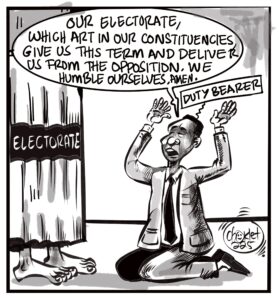With slightly over a fortnight since Zambia went to the polls and ushered in a new administration, expectations for the new Government are high as stakeholders within and outside the country await to see the policy direction that Government will take, with more stakeholders particularly interested to see the economic recovery strategy that will be put in place. In last week’s opinion piece, I analyzed the possible implications of the International Monetary Fund (IMF)’s recent Special Drawing Rights (SDR) allocation of $1.3 billion to Zambia. I argued that dedicating a larger part of these resources to the stabilization of the exchange rate has potential to contributeto macroeconomic stability. This week, I broaden the conversation by relying upon the ruling United Party for National Development (UPND) manifesto as a lens through which I assess the prospects for economic recovery under the new administration.
At the backdrop of these economic recession that Zambia experienced in 2020, was the COVID-19 pandemic and the increased stock of public debt. Therefore, the economic recovery strategy that will be put forth is expected to somewhat seek to address the implications of these two variables on the economy. Based on its manifesto, the UPND Government’s economic management strategy highlights the need to “implement a development agenda of economic transformation”. To achieve this, a number of specific interventions have been outlined, the thrust of which, are anchored on enhancing domestic revenue generation while rationalizing public expenditure, with more emphasis put on ensuring budget credibility.
Besides all the technicalities surrounding actual policy formulation, one undeniable attribute that the UPND Government seems to have brought to the table thus far, albeit it being too early to be fully appreciated, is increased public and investor confidence in the leadership of the Nation. This is seen in how the financial markets responded to the political transition as yield rates on Zambia’s Eurobonds surged while the Kwacha appreciated steadily, dropping to around K15/$ from an average of K20/$ prior to the transition. Additionally, the recent pronouncement by the United Kingdom(UK) Government,committing about £ 9 million in support of Zambia’s education sector and Small and Medium sized businesses has potential to lead to more of such interventions from other bilateral and multilateral cooperating partners. These developments signal a good start to the new administration and enhances the prospects for a speedy economic recovery.
This notwithstanding, it is critical to note that there has been no significant shift in the fundamental variables that underpin economic performance. While increased investor confidence can attract investors, it is actual policy implementation that will make them stay. Therefore, the sustainability of the macro-economic developments so far observed largely depends on how quickly the new administration settles down and begins to implement most of the pronouncements outlined in the party manifesto and their economic recovery strategy which many are yet to see.
I now outline some of the key areas which the new Government could focus on to ensure sustainability of the economic recovery trend:
• The previous administration had made substantive progress in terms of engaging the International Monetary Fund on a possible Extended Credit Facility program. It is important to note that most of these discussions were premised on the Economic Recovery Program (2020-2023) which was prepared and launched by the past administration. Therefore, ‘reinventing the wheel’ could take us many steps back. It will be cardinal for the new administration to quickly review the ERP so that it reflects the current Government’s economic recovery strategy, without completely shifting the thrust of the document. Concluding a formal program with the IMF will be key to ensuring a successful debt restructuring process.
• The new administration should consider re-invigorating the economic diversification agenda. This will involve commercializing the agriculture sector by increasing production, pursuing crop diversification, enhancing value addition and improving access to both domestic and regional markets within the sector.
• Efforts to support other sectors under the economic diversification agenda should be complimented by interventions to ensure the mining sector, which currently is the backbone of Zambia’s economy, continues to thrive. With copper prices currently at decadal peaks, stimulating production in the sector has potential to increase inflows from Copper. However, there is also need to pursue a serious diversification agenda within the mining sector by exploring the mining of other minerals such as Gold, Manganese and Emerald as alternatives to copper. Broadly, it will be key for the new government to make its policy on mining clear. This should involve putting in place a predictable, consistent and internationally competitive Mining Taxation Regime which ensures that mining companies operate efficiently while Government receives a fair share from the outputs thereof.
About the author: Mr. Wakumelo Mataa is a Researcher for Public Finance at the Centre for Trade Policy and Development
























